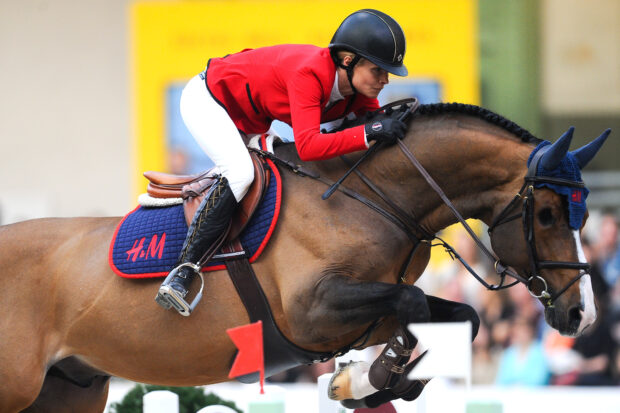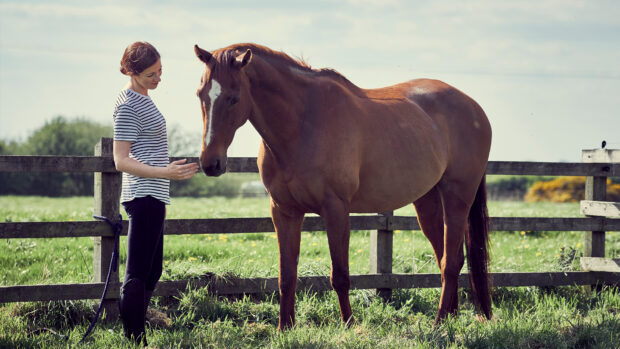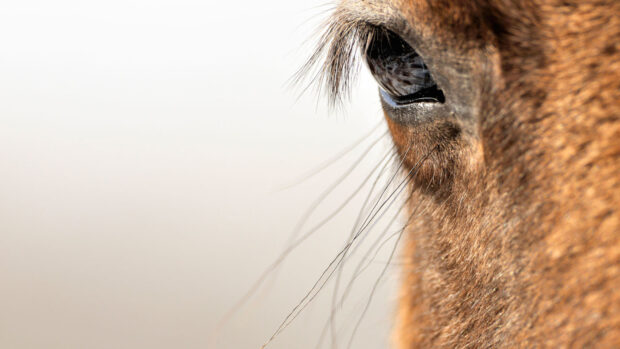Equine eyes are located on the sides of the head, giving horses a much larger field of view than humans. With head held at normal height, they possess an almost complete field of vision around them.
The relatively forward position of the eyes provides a binocular overlap of about 55 to 65 degrees – in humans it is 120 degrees.
Blind areas exist only within a narrow region to the rear and in a small area perpendicular to the forehead and directly below the nose. Even so, a tiny shift of the head is enough to bring these areas into view.
Scientists have disproved the popular ramp retina theory, according to which horses brought objects into focus by raising or lowering their head so that images could fall onto different areas of the retina.
Research shows that the equine retina contains a narrow horizontal streak across the centre of the eye, which is densely packed with receptor cells called cones. This provides a band of acute vision.
Colour vision
Equine colour vision has been debated for years. In reality it seems horses are like humans with colour vision deficiencies.
Equine vision expert Dr Brian Timney, of the University of Western Ontario, explains: “Horses have little difficulty in discriminating red or blue from grey but with green and yellow, the results are mixed.”
Behavioural data, along with physical evidence that horses possess at least two types of cones (a must for some degree of colour vision), indicates that horses do see certain colours.
Research into horses’ night vision remains sparse, but the indications are that they see much better than humans in low light.
The equine retina has nine times as many rod receptors as cones. These receptors are responsible for vision in low light. This suggests good night vision.
So, how well does the horse see at a distance? Put it this way, if you are even moderately short-sighted, the chances are your horse can see better than you. Normal human vision is 20/20 – horses are rated at 20/30.
Research suggests that horses can also perceive depth. “Apparently, horses have many of the same depth-detecting skills that we have,” says Dr Timney. “They have true stereoscopic vision, despite having lateral eyes.”
So the horse’s visual world doesn’t differ much from ours – a little less colourful, a little bit blurry, but much broader and more useful at all times of the day and night.
The horse’s eyes look quite different from ours but essentially function similarly in many ways. As owners, trainers, handlers and caretakers, we must carefully consider this.
Fascinating facts
1. With almost panoramic vision, horses can see objects and movements that you would miss. Next time your horse becomes nervous, take a good look around, use your senses and watch his ears – they will be pointed at the object of his interest.
2. If you want your horse to clearly see where he is going, don’t ride him with his face set vertically. Researcher Alison Harman, from the University of Western Australia, found that, due to the visual streak, the horse’s binocular vision is directed down the nose. This means that if his face is vertical, he is confined to looking down at the ground and must rely on you for direction.
3. Be aware that horses may make colour associations – both positive and negative. If you always wear a blue shirt when involved in an unpleasant activity nearyour horse, he may start avoiding you, or anyone else, dressed in blue. Similarly, if your horse regularly avoids certain jumps, it’s worth considering that it could be because of the colour.
4. Trust your horse if riding after dark. You mightnot be able to see where you’re going, but he probably does. However, when quickly going from bright light to dim light, the equine eye needs time to adapt. Horses sometimes balk at barn or trailer doors simply because they cannot see inside.
5. Allow show jumpers to change the angle of their heads so they can use their depth perception to judge fences upon approach. You should train your horse to be responsible on a loose rein. Restricted riding with short reins limits vision, which often causes anxiety and can be dangerous.
6. Give your horse the chance to look around and investigate his surroundings. Both curious and cautious by nature, horses appreciate a handler or rider who acknowledges the way they think and perceive, so be patient.
| To read this interesting article in full, check out the NEW LOOK Summer issue of HORSE magazine.
Click here to subscribe to HORSE magazine, which is packed with useful horsecare and training features every month |



